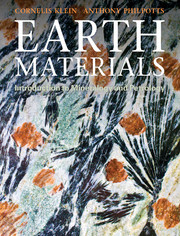Book contents
- Frontmatter
- Contents
- Preface
- Acknowledgments
- Chapter 1 Introduction
- Chapter 2 Materials of the solid Earth
- Chapter 3 How are minerals identified?
- Chapter 4 Fundamentals of crystal structures
- Chapter 5 Introduction to crystallography
- Chapter 6 Minerals and rocks observed under the polarizing optical microscope
- Chapter 7 Igneous rock-forming minerals
- Chapter 8 How do igneous rocks form?
- Chapter 9 Igneous rocks
- Chapter 10 Sedimentary rock-forming minerals and materials
- Chapter 11 Formation, transport, and lithification of sediment
- Chapter 12 Sedimentary rock classification, occurrence, and plate tectonic significance
- Chapter 13 Metamorphic rock-forming minerals
- Chapter 14 Metamorphic rocks
- Chapter 15 Some economic minerals, mainly from veins and pegmatites
- Chapter 16 Some selected Earth materials resources
- Chapter 17 Earth materials and human health
- Glossary
- Minerals and varieties
- Common igneous, sedimentary, and metamorphic rocks
- Index
- References
Chapter 8 - How do igneous rocks form?
- Frontmatter
- Contents
- Preface
- Acknowledgments
- Chapter 1 Introduction
- Chapter 2 Materials of the solid Earth
- Chapter 3 How are minerals identified?
- Chapter 4 Fundamentals of crystal structures
- Chapter 5 Introduction to crystallography
- Chapter 6 Minerals and rocks observed under the polarizing optical microscope
- Chapter 7 Igneous rock-forming minerals
- Chapter 8 How do igneous rocks form?
- Chapter 9 Igneous rocks
- Chapter 10 Sedimentary rock-forming minerals and materials
- Chapter 11 Formation, transport, and lithification of sediment
- Chapter 12 Sedimentary rock classification, occurrence, and plate tectonic significance
- Chapter 13 Metamorphic rock-forming minerals
- Chapter 14 Metamorphic rocks
- Chapter 15 Some economic minerals, mainly from veins and pegmatites
- Chapter 16 Some selected Earth materials resources
- Chapter 17 Earth materials and human health
- Glossary
- Minerals and varieties
- Common igneous, sedimentary, and metamorphic rocks
- Index
- References
Summary
Igneous rocks are those formed by the solidification of molten rock. This molten material, which we call magma, is formed at depth in the Earth and rises toward the surface, where it cools and solidifies, either beneath the surface, where it usually has time to crystallize, or on the surface as volcanic rocks, where cooling may be rapid enough to form glass. We classify igneous rocks on the basis of the minerals they contain, which are determined by the composition of the magma. Magma compositions are determined in the source region by the nature of the rock that undergoes partial melting, but they can be modified during ascent and solidification, especially in large magma chambers, where solidification can take thousands of years. Throughout geologic time, the rise of magmas from the mantle has slowly generated the Earth’s crust, whose composition is, therefore, determined by the composition of magmas.
We can think of an igneous rock as the end product of a lengthy series of processes, all of which play important roles in determining the rock’s composition, its appearance and mineral makeup, and the shape and position of igneous bodies it forms. It is these processes that we discuss in this chapter, leaving the mode of occurrence and classification of igneous rocks to Chapter 9. Many things can happen to magma between its formation as a partial melt in the source region and its eventual solidification to form a rock. In Box 8.1, we trace the three main types of magma from their sources to their final resting places. These magmas solidify to form the important rock types, basalt, andesite, and granite, which were introduced in Chapter 2. The first two of these are commonly associated with divergent and convergent plate boundaries, respectively.
- Type
- Chapter
- Information
- Earth MaterialsIntroduction to Mineralogy and Petrology, pp. 192 - 235Publisher: Cambridge University PressPrint publication year: 2012



